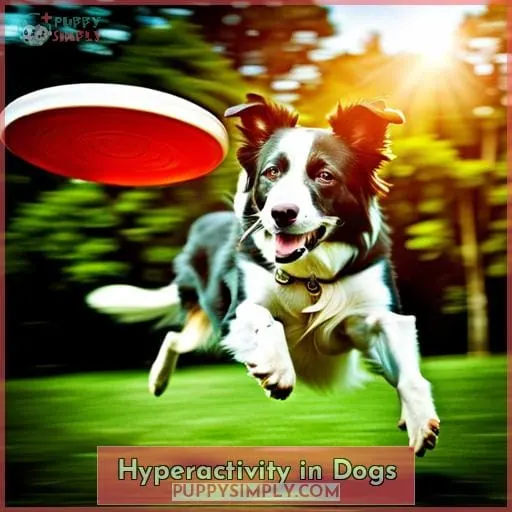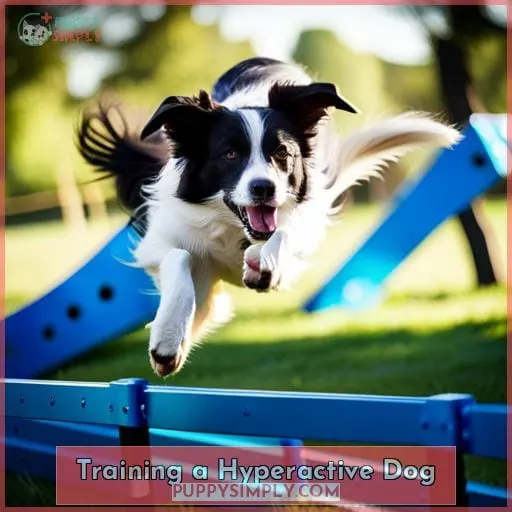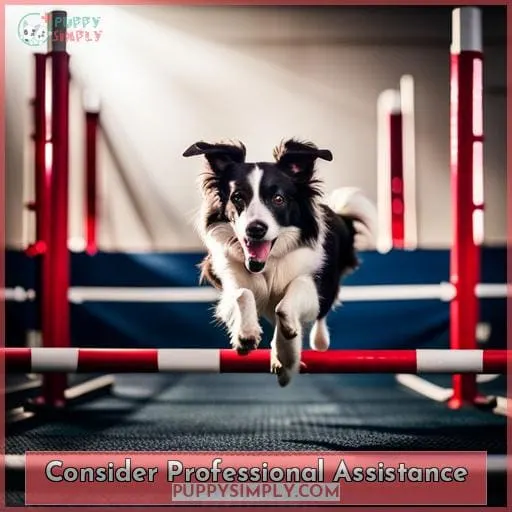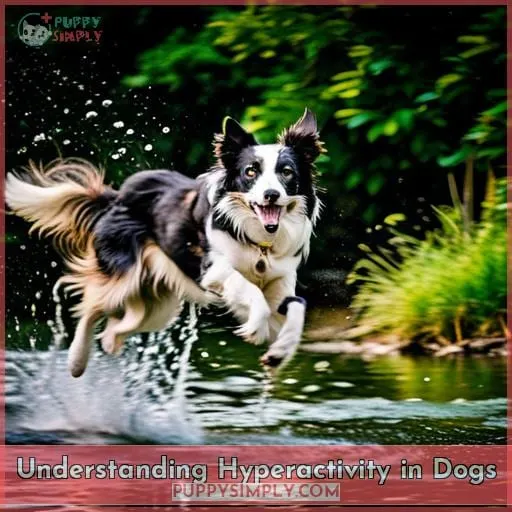This site is supported by our readers. We may earn a commission, at no cost to you, if you purchase through links.
 Does your high-energy dog’s hyperactivity make you feel out of control?
Does your high-energy dog’s hyperactivity make you feel out of control?
Don’t worry, you’re not alone.
With the right approach, you can train your dog to behave calmly and confidently.
In this article, you’ll discover expert tips and tricks to tame your dog’s hyperactivity, transforming them into a well-behaved companion.
Get ready to unlock the secrets of successful dog training and regain control of your home.
Table Of Contents
- Key Takeaways
- Hyperactivity in Dogs
- Training a Hyperactive Dog
- Calming Down a Hyperactive Dog
- Additional Tips for Calming Hyper Dogs
- Consider Professional Assistance
- Causes of Hyperactivity in Dogs
- Understanding Hyperactivity in Dogs
- Frequently Asked Questions (FAQs)
- How can I prevent my hyperactive dog from jumping on people when they enter the house?
- Are there any specific breeds of dogs that are more prone to hyperactivity?
- How can I ensure that my dog is getting enough mental stimulation along with physical exercise?
- When is the right time to consider hiring a professional dog trainer for my hyperactive dog?
- Are there any specific commands or training techniques that are particularly effective for hyperactive dogs?
- Conclusion
Key Takeaways
- Train your hyperactive dog using positive reinforcement and interactive toys for mental stimulation.
- Provide regular exercise (both physical and mental) and establish a structured exercise routine.
- Calm your dog down with physical affection, music, aromatherapy, or calming supplements.
- Seek professional assistance such as a dog trainer or medication if necessary.
Hyperactivity in Dogs
You’ll often find that hyperactivity in dogs is a result of insufficient exercise and lack of reinforcement for calm behavior.
This can lead to behavioral issues and even loss of home or life.
But don’t worry, with the right approach, you can help your hyperactive dog become a calm and well-behaved companion.
Positive reinforcement training is key.
Reward your dog for calm behavior and use interactive toys and mental stimulation to keep them engaged.
Make sure your dog gets plenty of exercise, both physical and mental.
A tired dog is a calm dog.
If your dog is still struggling, consider calming supplements or even medication.
With patience and consistency, you can help your hyperactive dog live a happy and fulfilling life.
Training a Hyperactive Dog
Often, you’ll train your hyperactive dog for just a few minutes at a time, but you’ll do it several times throughout the day.
Break training into small, frequent sessions to keep your dog engaged and prevent boredom.
Use interactive toys and mental stimulation:
- Engage your dog’s mind with puzzle toys, treat-dispensing balls, and interactive games.
- These activities provide mental stimulation and help tire out your dog.
Create a structured exercise routine:
- Regular exercise is key to managing hyperactivity.
- Aim for at least 30 minutes of moderate to vigorous exercise each day.
- This could include walks, runs, fetch, or swimming.
Incorporate enrichment activities:
- Provide your dog with opportunities to explore and engage their senses.
- This could include sniffing games, hide-and-seek, or agility training.
Use positive reinforcement:
- Reward your dog with treats, praise, or petting when they exhibit calm behavior.
- This will help them associate calmness with positive outcomes.
Clicker training:
- Clicker training is an effective way to teach your dog new behaviors.
- Use a clicker to mark the desired behavior and then immediately give your dog a treat.
- This helps them understand what you want them to do.
Calming Down a Hyperactive Dog
Once you’ve made progress training your hyperactive dog, you can start implementing calming techniques to help them stay relaxed and focused.
Calming Techniques for Hyperactive Dogs
Physical Affection:
- Reduces anxiety and stress
- Hold, pet, or massage your dog
Music or Aromatherapy:
- Creates a calming environment
- Play classical music or use calming scents
Calming Supplements:
- May help reduce hyperactivity
- Consult your veterinarian before use
Exercise Alternatives:
- Provides mental and physical stimulation
- Try indoor activities or alternative exercise options
With patience and consistency, you can help your hyperactive dog achieve a calm and happy future.
Additional Tips for Calming Hyper Dogs
Moving forward, you can also try dressing your hyperactive dog in a calming vest and ensuring it’s properly socialized. This can help reduce anxiety and promote relaxation. Additionally, make sure your hyperactive dog gets enough exercise to exhaust pent-up energy.
-
Calming Supplements:
Consider giving your dog calming supplements like chamomile, pet-friendly CBD oils, or melatonin. These supplements can help reduce anxiety and promote relaxation.
-
Indoor Activities:
Engage your dog in indoor activities when outdoor exercise is limited. Play games like Find It! or Hide and Seek to stimulate their minds and burn off energy.
-
Positive Reinforcement:
Use positive reinforcement training to reward your dog for calm behavior. This will help them associate calmness with positive outcomes.
-
Short Commands:
Use short, clear commands when training your dog. This will help them understand what you want them to do more easily.
Consider Professional Assistance
If you’re struggling to manage your hyperactive dog’s behavior, consider:
- Hiring a professional dog trainer.
- Attending training classes.
Professional assistance can help you:
- Understand your dog’s behavior.
- Develop a training plan that works for both of you.
Hire Professional Trainer
If other calming techniques don’t work and you’re at your wit’s end, hiring a professional dog trainer could be the answer.
They’ll assess your dog’s behavior, create a tailored training plan, and guide you through the process.
Choose a trainer certified by reputable organizations like the CCPDT or APDT.
Ask about their experience with hyperactive dogs and their training methods.
The cost of training varies, so compare prices and services before deciding.
A good trainer can help you achieve training success and restore harmony to your household.
Attend Training Classes
Consider attending group training classes with your dog to learn effective training techniques from experienced professionals.
These classes offer a structured environment where you and your dog can learn:
- Basic commands
- Socialization skills
- How to manage hyperactivity
You’ll also benefit from the class dynamics, which can help your dog learn from other dogs and owners.
Training workshops and behavioral seminars can also provide valuable insights into your dog’s behavior and how to address hyperactivity.
Consider Medication
Can medication be an option if other calming techniques haven’t helped your hyperactive dog?
Discuss medication considerations with your veterinarian.
They can guide you through behavioral therapies, holistic approaches, and lifestyle modifications that might suit your dog’s unique needs.
Causes of Hyperactivity in Dogs
You’re not alone if you have a hyperactive dog.
Hyperactivity in dogs is often caused by:
- A lack of exercise
- Insufficient training
- Genetics
The good news is that you can help your dog calm down and behave better with some patience and training.
Causes of Hyperactivity
You’ll need to understand the causes of hyperactivity in dogs before you can begin training.
Hyperactivity can stem from:
- Breed factors, like high-energy breeds bred for work.
- Environmental triggers like boredom and anxiety.
- Behavioral reinforcement, where hyperactivity is rewarded with attention.
- Insufficient physical exercise and mental stimulation, leading to pent-up energy and hyperactivity.
Understanding these causes is the first step to creating a tailored training plan for your dog.
Calming Techniques
With a combination of mental stimulation, physical activity, and positive reinforcement, you can help your hyperactive dog achieve a calmer state of mind.
Calming Techniques:
- Aromatherapy: Promotes relaxation and reduces anxiety.
- Canine Classical Music: Soothes and calms your dog’s nervous system.
- Calming Vest: Provides a sense of security and reduces stress.
- CBD Oil Usage: Natural and safe way to reduce hyperactivity and anxiety.
- Melatonin for Dogs: Helps regulate sleep-wake cycles and promotes calmness.
Professional Assistance
Professional assistance can help you understand the underlying causes of your dog’s hyperactivity.
Canine therapists can:
- Assess your dog’s behavior
- Identify triggers
- Create a tailored training plan
Training workshops can teach you effective techniques to manage your dog’s hyperactivity.
If anxiety is a root cause, behavioral experts may recommend anxiety medication.
Seeking professional assistance demonstrates your commitment to resolving your dog’s hyperactivity and improving their overall well-being.
Understanding Hyperactivity in Dogs
Understanding hyperactivity in dogs unravels the underlying causes of their boundless energy.
Canine anxiety, often misdiagnosed as hyperactivity, stems from a lack of proper exercise and insufficient reinforcement for calm behavior.
Your dog’s hyperactivity may be a cry for help, a plea for mental stimulation, or a sign of pent-up energy.
Behavioral modification programs, rooted in positive reinforcement, help channel this energy into desirable behaviors, fostering a harmonious relationship between you and your furry friend.
Exercise, the cornerstone of any hyperactivity management strategy, not only burns excess energy but also sets the stage for successful training.
Indoor activities, such as hide-and-seek or puzzle toys, provide mental stimulation when outdoor exercise is limited.
Frequently Asked Questions (FAQs)
How can I prevent my hyperactive dog from jumping on people when they enter the house?
When guests enter:
- Keep your dog on a leash and have them sit.
- Reward them with treats and praise when they remain seated.
Repeat this process until they associate staying calm with positive reinforcement.
Are there any specific breeds of dogs that are more prone to hyperactivity?
Certain breeds, like Border Collies and Jack Russell Terriers, possess inherent traits that predispose them to boundless energy and a propensity for hyperactivity.
Understanding these breed-specific characteristics can help you tailor training strategies to effectively manage their exuberant nature.
How can I ensure that my dog is getting enough mental stimulation along with physical exercise?
To ensure your dog’s mental agility:
Engage them in interactive games like fetch or hide-and-seek.
When is the right time to consider hiring a professional dog trainer for my hyperactive dog?
Consider professional help if your hyperactive dog’s behavior doesn’t improve with:
- Consistent training
- Positive reinforcement
- Sufficient exercise
A trainer can guide you toward lasting solutions.
Are there any specific commands or training techniques that are particularly effective for hyperactive dogs?
Harness your dog’s boundless energy with targeted commands like settle and focus.
These anchors of calm amidst the storm will guide your dog toward serenity and attentive obedience.
Conclusion
Imagine the joy of having your dog calmly sit by your side, instead of jumping and barking incessantly.
With consistent training and positive reinforcement, you can transform your hyperactive dog into a well-behaved companion.
So, take the first step today and start implementing these tips to train your hyperactive dog like a pro.













